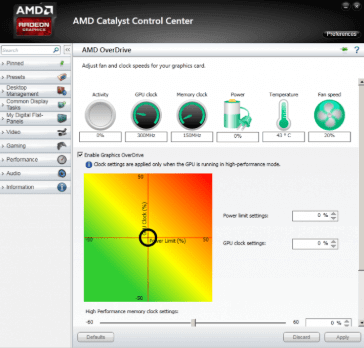
- #Sapphire trixx fury msi afterburner perfect settings how to#
- #Sapphire trixx fury msi afterburner perfect settings full#
- #Sapphire trixx fury msi afterburner perfect settings download#
Wattman, while a simple and convenient tool to use, lacks the feature I need most. To achieve a mere 5% increase in clock speed, I will have to increase my voltage.
#Sapphire trixx fury msi afterburner perfect settings full#
This would be acceptable if it were not the fact that, through trial and error, I have discovered that my card, with the power limit set to +50% and the fans screaming at the full 100% fan speed, can not maintain 1100mhz. While I could increase the power limits by up to +50%, and could manually input the voltages, I could not raise my voltages beyond 1.250V - which is the stock voltage for my card’s final power stage when it operates at 1050mhz. However, I came across a feature most inconvenient. The basics are there, and fairly intuitive to use. Having access to the various power stages, and being able to manually input the voltage and clock rates for each individual stage was an interesting and fairly straightforward feature. Still striving to try something different, I explored AMD’s overclocking solution: Wattman. Once effected, the only way to undo the bug is to do a system reboot. Resetting defaults via the program’s interface has no effect the same with closing or restarting the program.

It even overrides powertune’s capacity to affect the clock rates, and attempts to “free” or modify the clock settings can not by done with other overclocking programs once this “bug” has been effected. This turned out to be a frustrating assumption, as simply pressing the “apply” button on the interface causes the card to be locked in its lowest power stage.
#Sapphire trixx fury msi afterburner perfect settings download#
I figured using Sapphire’s overclocking solution, Trixx, would be an fun route to take, and went to their website to download the latest version, v6.4.0, which was released 5/8/17. Preliminary testing has not been favorable in the least. This is exploring the limits of what my card has to offer. Depending on your luck, for minimal performance hits, you may end up shaving almost 100 watts of power consumption, which is impressive to say the least.īut we’re not chasing efficiency. As laid out in this Tom’s Hardware article, there is a lot of efficiency to be gained by undervolting. While performance may scale with an increase in clock speed, power consumption required for increased speeds can be described as absurd for an 5% increase in clock speed, with comparable increase in gaming performance, your power consumption may increase by as much as 25%, depending on amount of voltage you have to feed the card.įar more success and satisfaction can be had by attempting undervolting. Why? Overclocking the Fury line-up of cards is, by and large, a fool’s errand.

Up until this point, I have never bothered overclocking my card. This will be a multi-post, and probably multi-stage, process, and I hope others join in with their findings, or suggestions, as I make this journey. I’m just a guy that wants to tinker and get more power - correction, MOAR POWR!!!1111oneoneone But, I am not an electrical engineer that can pontificate and explain how certain design choices can limit the performance of this card. While it is the higher binned variant of Sapphire’s offerings, clocking in at 1050mhz, it already near the maximum limitations that its silicon has to offer - not that the limitations imposed by the architecture, and the functions of Powertune help. Give it a watch, then consider the tools listed in the article above.In this thread, I plan to chronicle the trials and tribulations of overlocking my Sapphire Nitro R9 Fury OC+. The following video is a handy guide on the basics of overclocking.
#Sapphire trixx fury msi afterburner perfect settings how to#
Related: How to Prevent Computer Overheating and Keep Your PC Cool Is Overclocking a GPU Difficult?Īs with most things, it doesn't have to be, so long as you take your time and watch or read some tutorials first. But, it may not be stable at all times, and your GPU may throttle down because of the increased temperatures if you don't have a good cooling system in place. Yes, GPU overclocking can give you a 10-15 percent gaming performance boost. Always research your specific GPU specs and limits before overclocking.

Please note that this is general advice and MakeUseOf is not responsible for any hardware damage that comes from overclocking. Most modern GPUs will cut out before anything truly awful happens. This is usually a sign that you went overboard in overclocking your GPU, so pulling back the clock speed a notch should fix this up.

But, do not worry, because the worst that can happen is maybe a crash, freeze, or a blue or black screen, which is easily fixable with a simple restart of your computer. GPU overclocking can increase your operating temperatures, putting more stress on your GPU. Here are some frequently asked questions about GPU overclocking and their answers.


 0 kommentar(er)
0 kommentar(er)
